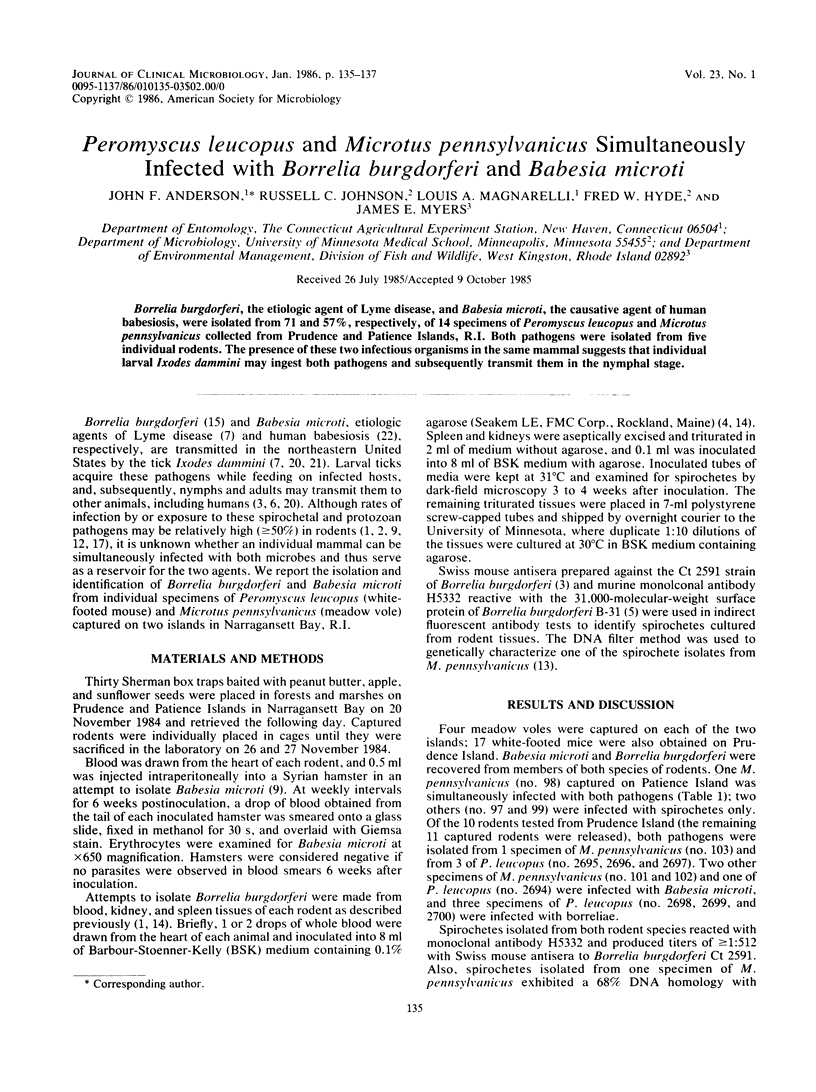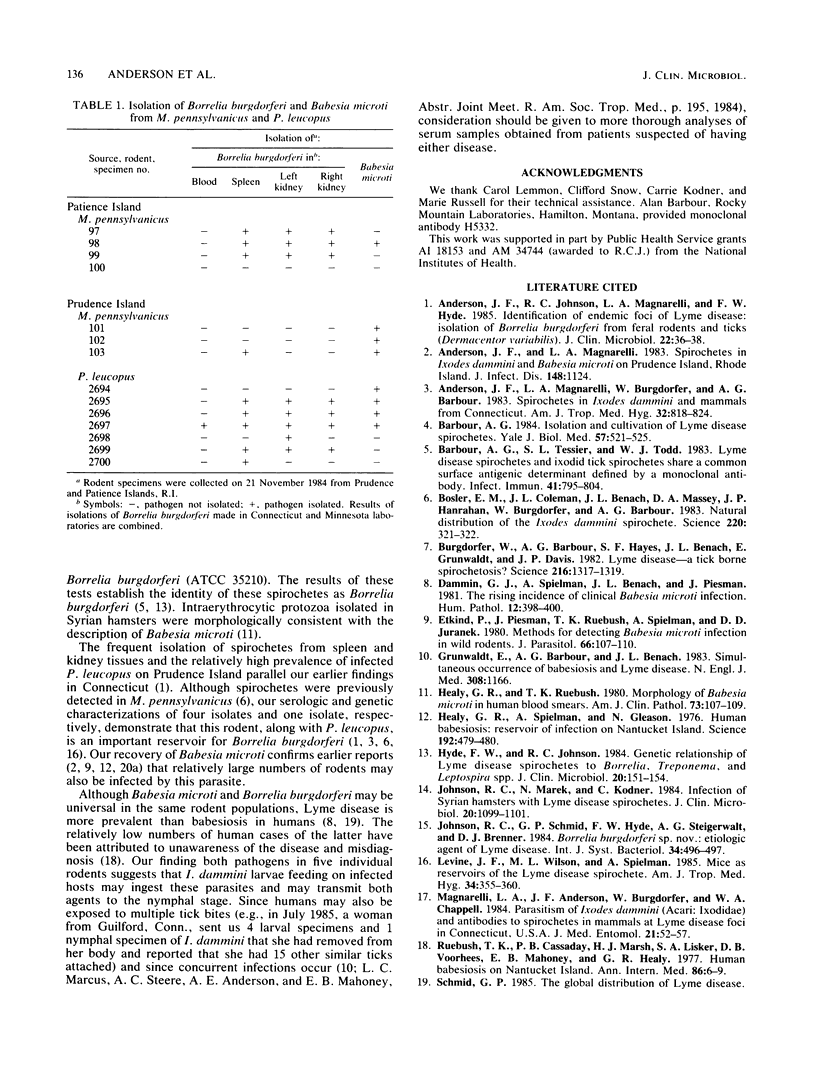Abstract
Borrelia burgdorferi, the etiologic agent of Lyme disease, and Babesia microti, the causative agent of human babesiosis, were isolated from 71 and 57%, respectively, of 14 specimens of Peromyscus leucopus and Microtus pennsylvanicus collected from Prudence and Patience Islands, R.I. Both pathogens were isolated from five individual rodents. The presence of these two infectious organisms in the same mammal suggests that individual larval Ixodes dammini may ingest both pathogens and subsequently transmit them in the nymphal stage.
Full text
PDF


Selected References
These references are in PubMed. This may not be the complete list of references from this article.
- Anderson J. F., Johnson R. C., Magnarelli L. A., Hyde F. W. Identification of endemic foci of Lyme disease: isolation of Borrelia burgdorferi from feral rodents and ticks (Dermacentor variabilis). J Clin Microbiol. 1985 Jul;22(1):36–38. doi: 10.1128/jcm.22.1.36-38.1985. [DOI] [PMC free article] [PubMed] [Google Scholar]
- Anderson J. F., Magnarelli L. A., Burgdorfer W., Barbour A. G. Spirochetes in Ixodes dammini and mammals from Connecticut. Am J Trop Med Hyg. 1983 Jul;32(4):818–824. doi: 10.4269/ajtmh.1983.32.818. [DOI] [PubMed] [Google Scholar]
- Anderson J. F., Magnarelli L. A. Spirochetes in Ixodes dammini and Babesia microti on Prudence Island, Rhode Island. J Infect Dis. 1983 Dec;148(6):1124–1124. doi: 10.1093/infdis/148.6.1124. [DOI] [PubMed] [Google Scholar]
- Barbour A. G. Isolation and cultivation of Lyme disease spirochetes. Yale J Biol Med. 1984 Jul-Aug;57(4):521–525. [PMC free article] [PubMed] [Google Scholar]
- Barbour A. G., Tessier S. L., Todd W. J. Lyme disease spirochetes and ixodid tick spirochetes share a common surface antigenic determinant defined by a monoclonal antibody. Infect Immun. 1983 Aug;41(2):795–804. doi: 10.1128/iai.41.2.795-804.1983. [DOI] [PMC free article] [PubMed] [Google Scholar]
- Bosler E. M., Coleman J. L., Benach J. L., Massey D. A., Hanrahan J. P., Burgdorfer W., Barbour A. G. Natural Distribution of the Ixodes dammini spirochete. Science. 1983 Apr 15;220(4594):321–322. doi: 10.1126/science.6836274. [DOI] [PubMed] [Google Scholar]
- Burgdorfer W., Barbour A. G., Hayes S. F., Benach J. L., Grunwaldt E., Davis J. P. Lyme disease-a tick-borne spirochetosis? Science. 1982 Jun 18;216(4552):1317–1319. doi: 10.1126/science.7043737. [DOI] [PubMed] [Google Scholar]
- Dammin G. J., Spielman A., Benach J. L., Piesman J. The rising incidence of clinical Babesia microti infection. Hum Pathol. 1981 May;12(5):398–400. doi: 10.1016/s0046-8177(81)80020-2. [DOI] [PubMed] [Google Scholar]
- Etkind P., Piesman J., Ruebush T. K., 2nd, Spielman A., Juranek D. D. Methods for detecting Babesia microti infection in wild rodents. J Parasitol. 1980 Feb;66(1):107–110. [PubMed] [Google Scholar]
- Grunwaldt E., Barbour A. G., Benach J. L. Simultaneous occurrence of babesiosis and Lyme disease. N Engl J Med. 1983 May 12;308(19):1166–1166. doi: 10.1056/NEJM198305123081919. [DOI] [PubMed] [Google Scholar]
- Healy G. R., Ruebush T. K., 2nd Morphology of Babesia microti in human blood smears. Am J Clin Pathol. 1980 Jan;73(1):107–109. doi: 10.1093/ajcp/73.1.107. [DOI] [PubMed] [Google Scholar]
- Healy G. R., Speilman A., Gleason N. Human babesiosis: reservoir in infection on Nantucket Island. Science. 1976 Apr 30;192(4238):479–480. doi: 10.1126/science.769166. [DOI] [PubMed] [Google Scholar]
- Hyde F. W., Johnson R. C. Genetic relationship of lyme disease spirochetes to Borrelia, Treponema, and Leptospira spp. J Clin Microbiol. 1984 Aug;20(2):151–154. doi: 10.1128/jcm.20.2.151-154.1984. [DOI] [PMC free article] [PubMed] [Google Scholar]
- Johnson R. C., Marek N., Kodner C. Infection of Syrian hamsters with Lyme disease spirochetes. J Clin Microbiol. 1984 Dec;20(6):1099–1101. doi: 10.1128/jcm.20.6.1099-1101.1984. [DOI] [PMC free article] [PubMed] [Google Scholar]
- Levine J. F., Wilson M. L., Spielman A. Mice as reservoirs of the Lyme disease spirochete. Am J Trop Med Hyg. 1985 Mar;34(2):355–360. doi: 10.4269/ajtmh.1985.34.355. [DOI] [PubMed] [Google Scholar]
- Magnarelli L. A., Anderson J. F., Burgdorfer W., Chappell W. A. Parasitism by Ixodes dammini (Acari: Ixodidae) and antibodies to spirochetes in mammals at Lyme disease foci in Connecticut, USA. J Med Entomol. 1984 Jan 26;21(1):52–57. doi: 10.1093/jmedent/21.1.52. [DOI] [PubMed] [Google Scholar]
- Reubush T. K., 2nd, Cassaday P. B., Marsh H. J., Lisker S. A., Voorhees D. B., Mahoney E. B., Healy G. R. Human babesiosis on Nantucket Island. Clinical features. Ann Intern Med. 1977 Jan;86(1):6–9. doi: 10.7326/0003-4819-86-1-6. [DOI] [PubMed] [Google Scholar]
- Schmid G. P. The global distribution of Lyme disease. Rev Infect Dis. 1985 Jan-Feb;7(1):41–50. doi: 10.1093/clinids/7.1.41. [DOI] [PubMed] [Google Scholar]
- Spielman A., Etkind P., Piesman J., Ruebush T. K., 2nd, Juranek D. D., Jacobs M. S. Reservoir hosts of human babesiosis on Nantucket Island. Am J Trop Med Hyg. 1981 May;30(3):560–565. doi: 10.4269/ajtmh.1981.30.560. [DOI] [PubMed] [Google Scholar]
- Spielman A. Human babesiosis on Nantucket Island: transmission by nymphal Ixodes ticks. Am J Trop Med Hyg. 1976 Nov;25(6):784–787. doi: 10.4269/ajtmh.1976.25.784. [DOI] [PubMed] [Google Scholar]
- Steere A. C., Malawista S. E. Cases of Lyme disease in the United States: locations correlated with distribution of Ixodes dammini. Ann Intern Med. 1979 Nov;91(5):730–733. doi: 10.7326/0003-4819-91-5-730. [DOI] [PubMed] [Google Scholar]
- Western K. A., Benson G. D., Gleason N. N., Healy G. R., Schultz M. G. Babesiosis in a Massachusetts resident. N Engl J Med. 1970 Oct 15;283(16):854–856. doi: 10.1056/NEJM197010152831607. [DOI] [PubMed] [Google Scholar]


